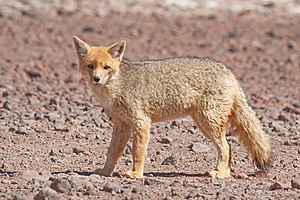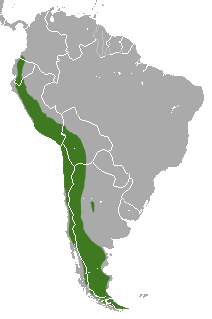안데스여우
안데스여우 또는 쿨페오(culpeo, Lycalopex culpaeus)는 남아메리카에 서식하는 개과 동물이다. 갈기늑대에 이어 남아메리카에서 두번째로 큰 개과 동물이다.
|
| |
|---|---|
 | |
| 생물 분류ℹ️ | |
| 계: | 동물계 |
| 문: | 척삭동물문 |
| 강: | 포유강 |
| 목: | 식육목 |
| 과: | 개과 |
| 아과: | 개아과 |
| 속: | 남아메리카여우속 |
| 종: | 안데스여우 (L. culpaeus) |
| 학명 | |
| Lycalopex culpaeus | |
| (Molina, 1782) | |
| 쿨페오의 분포 | |
 | |
| 보전상태 | |
|
| |
계통 분류
편집| 개과 |
| |||||||||||||||||||||||||||||||||||||||||||||||||||||||||||||||||||||||||||||||||||||||||||||||||||||||||||||||||||||||||||||||||||||||||||||||||||||||||||||||||||||||||||||||||||||||||||||||||||||||||||||||||||||||||||
각주
편집- ↑ Lindblad-Toh, Kerstin; Wade, Claire M; Mikkelsen, Tarjei S.; Karlsson, Elinor K.; Jaffe, David B.; Kamal, Michael; Clamp, Michele; Chang, Jean L.; Kulbokas, Edward J.; Zody, Michael C.; Mauceli, Evan; Xie, Xiaohui; Breen, Matthew; Wayne, Robert K.; Ostrander, Elaine A.; Ponting, Chris P.; Galibert, Francis; Smith, Douglas R.; Dejong, Pieter J.; Kirkness, Ewen; Alvarez, Pablo; Biagi, Tara; Brockman, William; Butler, Jonathan; Chin, Chee-Wye; Cook, April; Cuff, James; Daly, Mark J.; Decaprio, David; 외. (2005). “Genome sequence, comparative analysis and haplotype structure of the domestic dog”. 《Nature》 438 (7069): 803 in 803–19. doi:10.1038/nature04338. PMID 16341006.
- ↑ Nyakatura, K.; 외. (2012). “Updating the evolutionary history of Carnivora (Mammalia): a new species-level supertree complete with divergence time estimates”. 《BMC Biology》 10 (12). doi:10.1186/1741-7007-10-12.
- ↑ Koepfli, Klaus-Peter; Pollinger, John; Godinho, Raquel; Robinson, Jacqueline; Lea, Amanda; Hendricks, Sarah; Schweizer, Rena M.; Thalmann, Olaf; Silva, Pedro; Fan, Zhenxin; Yurchenko, Andrey A.; Dobrynin, Pavel; Makunin, Alexey; Cahill, James A.; Shapiro, Beth; Álvares, Francisco; Brito, José C.; Geffen, Eli; Leonard, Jennifer A.; Helgen, Kristofer M.; Johnson, Warren E.; o'Brien, Stephen J.; Van Valkenburgh, Blaire; Wayne, Robert K. (2015). “Genome-wide Evidence Reveals that African and Eurasian Golden Jackals Are Distinct Species”. 《Current Biology》 25 (16): 2158–65. doi:10.1016/j.cub.2015.06.060. PMID 26234211.
| 이 글은 포유류에 관한 토막글입니다. 여러분의 지식으로 알차게 문서를 완성해 갑시다. |
